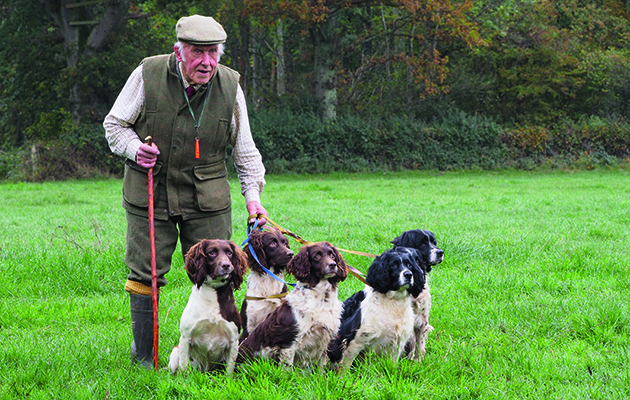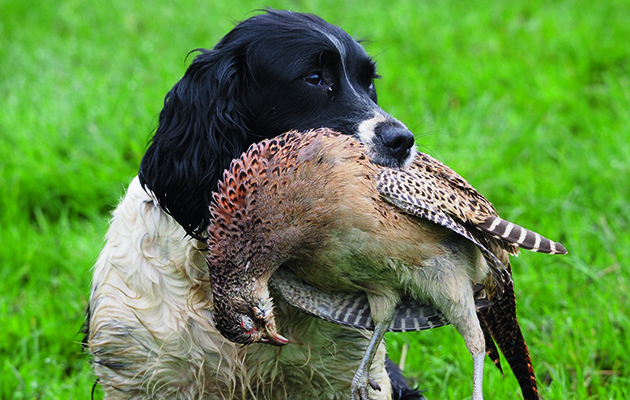Win CENS ProFlex DX5 earplugs worth £1,149 – enter here
Meet George Butler the springer specialist
 OLYMPUS DIGITAL CAMERA
OLYMPUS DIGITAL CAMERA
To describe George Butler as the best-known picker-up in Sussex is something of an understatement. George is not only famous throughout the county for his team of English springers — invariably working at least half a dozen at a time — but also for the annual shoot evening that he started on behalf of what was the Game Conservancy and is now the Game & Wildlife Conservation Trust (GWCT). This year was his 33rd such evening: it raised an impressive £19,000, the best so far.
I first read about George three years ago when the GWCT’s newsletter, Gamewise, announced to his many friends in the shooting world that he had been awarded the MBE for services to agriculture and charity. Apart from a couple of years away in Malaya on national service, from 1953- 1955, he has always been involved with his family farm, a dairy enterprise in which he works in partnership with his brother and nephew. Now aged 82, and with a body that is a stark reminder of the physical nature of dairy farming — “Carting about all those bags of fertiliser,” he says — you might expect George to enjoy putting his feet up, but not a bit of it. He’s already planning his 34th shoot evening, and continues to pickup with his spaniels most days of the week. He and his team did 87 days last year; this season he anticipates doing a similar number, depending on the weather.
George bought his first working springer, a nine-month-old called Julie, in 1957. She cost £8, and was bought unseen from an advertisement in Shooting Times. That sum included carriage, for she travelled down from Cheshire to Haywards Heath by train, from where George collected her. His excitement at meeting her was tempered by the discovery that she was suffering from an umbilical hernia, which explained why she was the last of the litter to be sold. Undeterred, George took her to the vet who charged him £4 for her operation, half her purchase price. It was money well spent, for she became the foundation bitch for his line of spaniels. It’s still going strong today, 12 generations on.
When I joined George picking-up on a 300-bird day on a shoot in the Sussex Weald, he had six springers out. They were all bitches, but though he admits to a preference for girls, his current pack of 13 springers includes what he describes as “a very promising 15-month-old dog. I think that he’s going to be very good.”
With his spaniels working so many days a season, chiefly on shoots where the bags are substantial, he nds it pays to have two teams. When he bred from Julie he kept a bitch he called Simba. From that day on, every dog he has owned has had a name beginning with “S”, which is quite an achievement over so many years. I met Susie, Sadie, Sorrell, Summer, Simone and Saffron, while it didn’t take long to discover that Saffron was the top dog.
“She has an outstanding nose,” George told me, adding that she was the most privileged member of his pack, sleeping in a bed next to his.
As I watched George work his dogs, one thing was abundantly clear. His spaniels are his best friends, and there’s a strong bond between them and their handler. They travel to shoots in a venerable 17-year old Land Rover Discovery, with Saffron on the front passenger seat. Best described as a mobile kennel, it’s a vehicle that has seen better days, but clearly serves its purpose well. “I’ve got a newer Discovery, too,” said George, “but this is the dogs’ car.”
Enthusiastic springers
George has strong views on spaniels. He likes traditional-looking springers with lots of colour, and has no time for the whippety white ones beloved of triallers. His dogs aren’t steady — they’re much too enthusiastic to sit when birds start to fall — but they work brilliantly during a drive, whisking the birds back to their master. Runners are picked as soon as they hit the ground and, with George’s dogs behind the pegs, very little gets away.
Help with handling the dogs comes from George’s shooting friend Tony Austin, with Tony’s springer, Grouse, joining the Butler pack for the day.
George remains deeply involved with the GWCT Sussex Shoot Evening, which he still organises. Held every March in Clair Hall in Haywards Heath, it draws up to 250 people, attracted by a combination of guest speakers, a buffet supper and a raffle, silent auction and auction of sporting opportunities. These last include some serious pheasant and partridge days, generously donated by shoot owners and landowners. George is a persuasive chap, and he plays a vital role in ensuring that the pledges continue to come in.
I asked George if he had ever considered any other breed than springers. “Never!” was his emphatic reply, adding that “the spaniels are my life”. That was certainly apparent from my day spent in their company.
George is well aware that because he is an octogenarian, some of his dogs may still be active when he’s not, so he assured me that they were all well provided for in his will. With someone like George as their master, you wouldn’t expect anything else.
Related Articles
Get the latest news delivered direct to your door
Subscribe to Shooting Times & Country
Discover the ultimate companion for field sports enthusiasts with Shooting Times & Country Magazine, the UK’s leading weekly publication that has been at the forefront of shooting culture since 1882. Subscribers gain access to expert tips, comprehensive gear reviews, seasonal advice and a vibrant community of like-minded shooters.
Save on shop price when you subscribe with weekly issues featuring in-depth articles on gundog training, exclusive member offers and access to the digital back issue library. A Shooting Times & Country subscription is more than a magazine, don’t just read about the countryside; immerse yourself in its most authoritative and engaging publication.








